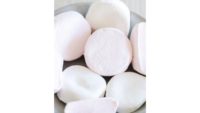Adding acacia gum—and reducing sugar content—is an effective way to improve the “Nutri-Score” of industrial biscuits. The clear health advantages align with consumer expectations—the French government-backed Nutri-Score nutritional rating system has become a benchmark for those looking to achieve a balanced diet.
The Alland & Robert Research & Development team carried out testing using a standard multigrain cookie recipe with a “C” Nutri-Score. Adding 3% acacia gum and reducing sugar content by 30% led to less fat and sugar, a lower calorie intake, and more fiber. From an initial “C” score, the modified recipe obtained an “A." The final recipe was adjusted to consider the impact of acacia gum on texture, appearance and sensory experience.
To support these findings, Alland & Robert then conducted consumer tests, which showed that the acacia gum cookies were generally preferred and classed as high quality during sensorial analysis. Their characteristics and nutritional value were improved compared to “control” recipes that did not contain any acacia gum. Similar results were achieved for other recipes. By adding acacia gum and reducing sugar, the Nutri-Score for muffins was upgraded from “D” to “C,” and a gluten-free chocolate cake moved from “E” to “D."
In the face of rising obesity levels and growing consumer demand, the food industry is being urged to limit the amount of sugar in products. As a low-viscosity texturing agent, acacia gum improves the mouthfeel of sugar-free and reduced-sugar recipes. When partially or totally replacing sugar, it induces a low glycemic response due to its high fiber content. Remaining stable at different temperatures, it can be easily added to a wide range of recipes.
Advantages of acacia gum:
- Less fat: Acacia gum helps compensate for reduced fat content in food applications such as salad dressings, sauces, and bakery products. It reduces the overall fat content and caloric density, while improving the Nutri-Score.
- Less sugar: Acacia gum can be used in nutrition bars as a binder. Its adhesive properties hold the ingredients together with no need for sugar or honey. It also compensates for the loss of texture and volume resulting from reduced sugar content, and acts as a flavor enhancer. Lower sugar content can therefore contribute to a better Nutri-Score.
- More fiber: Acacia gum is a dietary prebiotic fiber that can be incorporated into industrial food recipes. Given that fiber-rich products have a healthier nutritional profile, adding acacia gum can have a positive impact on the Nutri-Score.
- Fewer calories: Acacia gum contains relatively few calories compared to many other ingredients used in industrial food products. Replacing calorie-rich ingredients with acacia gum can therefore boost the Nutri-Score.
- Multi-talented: Acacia gum can be added to a multitude of food products, including sweets, soft drinks, and bread. It acts as a texturing agent, emulsifier, and stabilizer, as well as adding fiber. As a 100% plant-based ingredient, it represents an excellent alternative for vegetarian and vegan food products.




